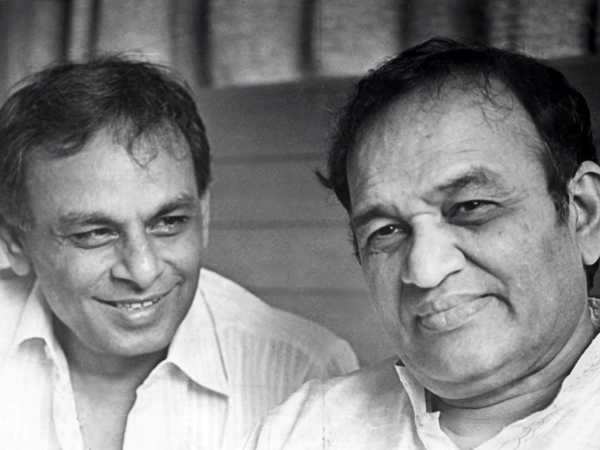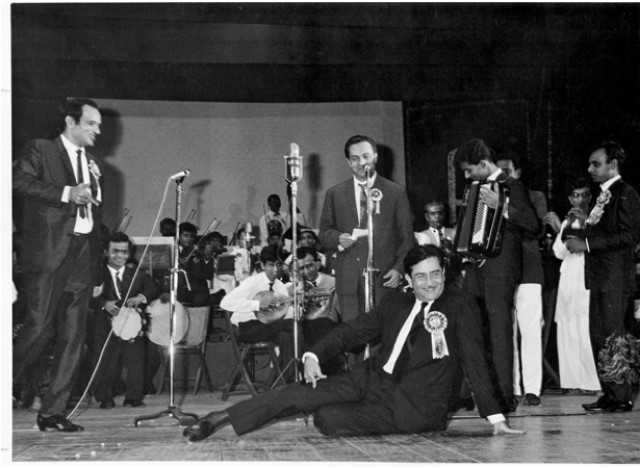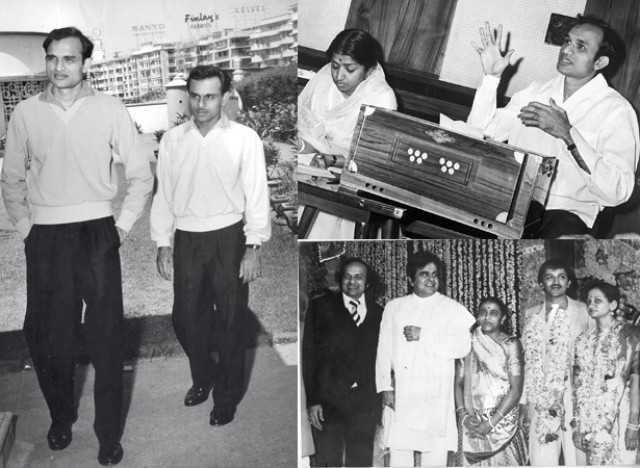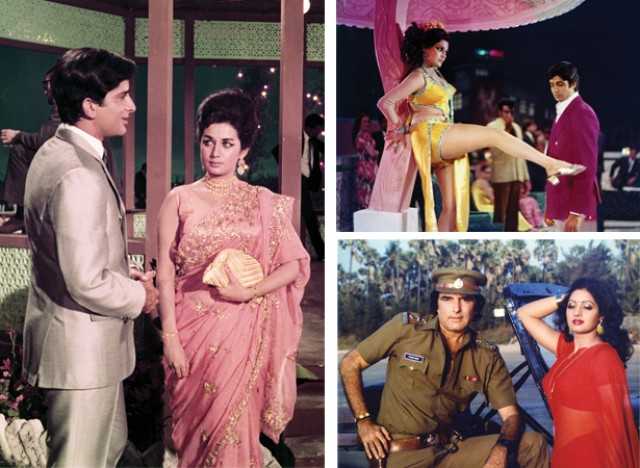
The talented brothers Kalyanji-Anandji never really got their due. In an era dominated by stalwarts such as SD Burman, Naushad, Shankar-Jaikishan and Madan Mohan, their music was often considered pedestrian and fit only for potboilers. Yet to persist with that line of reasoning would be a folly. One of the reasons they weren’t taken seriously was that unlike others, they weren’t able to form a team with leading stars like Dilip Kumar, Raj Kapoor, Dev Anand or Shammi Kapoor. The same goes for prominent directors too. Most of their music was made for those directors who were just making a name for themselves. It was only in the ’70s and the ’80s that their name came to be associated with filmmakers like Prakash Mehra, Feroz Khan and Sultan Ahmed – who were famous for their extravagant actioners with melodious music.

Raj Kapoor at a Kalyanji-Anandji show
Music merchants
Their father had migrated from Kutch to become a grain merchant but the brothers had no inclination of becoming shopkeepers. They started learning music at quite an early age and soon became proficient in it. An early prototype of synthesizer, called the Clayvioline was available then and Kalyanji became adept in playing it. He began assisting maestro Hemant Kumar and one of his famous contributions remains the haunting ‘been’ music played on the Clayvioline in the film Nagin (1954) under Kumar’s baton. The music became the talk of the town and gave the young man confidence to branch out on his own. Songs such as Chahe paas ho (Samrat Chandragupt – 1957), and O neend na mujhko aaye – sung by mentor Hemant Kumar and Mere dil mein hai ik baat from Post Box 999 (1958), marked their early successes. Anandji assisted him initially and joined him with Satta Bazar (1959) and another hyphenated musical duo was formed. Tumhe yaad hoga (again sung by Hemant Kumar) from Satta Bazar remains famous even today. Interestingly, they used the ‘been’ music again memorably in Madari (1959) in the song Dil lootnewale jaadugar.
Sweet ’60s
The duo came to be recognised as a formidable force with the Raj Kapoor starrer Chhalia (1960). Kapoor had always been associated with Shankar-Jaikishan and listeners initially thought that S-J had given Chhalia’s music as well. The fact that they used Mukesh so well in tunes like Dum dum diga diga, the title song (which was a specialty of S-J) Chhalia mera naam, and the pathos filled Mere toote hue dil se, contributed to the misunderstanding. Mukesh had a long association with S-J but it’s a lesser known fact that his association with Kalyanji-Anandji was quite deep too. They didn’t restrict his voice just to Raj Kapoor but had him sing for a plethora of stars ranging from Shammi Kapoor (Socha tha pyar hum na karenge – Bluff Master – 1963), Dharmendra (Mujhko iss raat ki tanhai mein – Dil Bhi Tera Hum Bhi Tere – 1960), Manoj Kumar (Chand si mehbooba ho meri – Himalay Ki God Mein –1965) and more names like Joy Mukherjee and Mehmood. Hit after hits like Himalay Ki God Mein, Upkar (1967), Saraswati Chandra (1968) and Vishwas (1969) further solidified their reputation. Interestingly, in an era where composers were going more and more Westernised (thanks to RD Burman’s influence), Kalyanji-Anandji were turning back to their roots and making their music more folk-based.
Saraswati Chandra is a case in point. Its music had the fragrance of Gujarat and songs like O main to bhool chali babul ka des are heard at garbas even today. The composer duo had the knack of making songs that fit popular occasions – Govinda aa laa re from Bluffmaster is a staple at every Janamashtmi festival, Mere desh ki dharti from Upkar is heard on patriotic occasions like the Independence Day and the Republic Day and no marriage is complete without Meri pyari behaniya bangei dulhania from Saccha Jhuta (1970) blaring in the background.
Roaring ’70s
The duo kind of dominated the ’70s along with RD Burman and erstwhile assistants Laxmikant-Pyarelal. Hits like Gopi (1970) – where they gave Dilip Kumar one of the most memorable bhajans of his career, Sukh me sab saathi. They later did Purab Aur Paschim (1970), Holi Aayee Re (1970), Victoria No 203 (1972), where they created the famous Do bechare duet sung by Mahedra Kapoor and Kishore Kumar, picturised on Pran and Ashok Kumar. Blackmail (1973), which has the evergreen Pal pal dil ke paas, is perhaps one of the most romantic songs sung by Kishore. These showcased their versatility.
They also hopped on to the wagon of the rising star Rajesh Khanna with films like Safar (1970), which had the haunting Jeevan se bhari as also the tragic Zindagi ka safar sung by Kishore, Sachha Jhutha and Maryada both in 1971. They also got the big ticket Johny Mera Naam (1970), starring Dev Anand and directed by his brother Vijay Anand in their kitty. The mesmerising Pal bhar ke liye koi hamein pyar kar le is hummed even today. It was a crime thriller but they proved that even such films could have melodious music. The duo later won the Filmfare Award for Kora Kagaz, starring Vijay Anand. The music was unlike their usual oeuvre and it’s said Kishore Kumar threw a huge party in their honour after they won the trophy.
They were also lucky in giving music for Zanjeer (1973), considered to be the turning point of Amitabh Bachchan’s career. That led to them bagging films like Faraar (1975), Do Anjaane (1976), Hera Pheri (1976), Khoon Pasina (1977), Don (1978) and Muqaddar Ka Sikandar (1978), starring the superstar. Most of these films were blockbuster hits and helped further their standing. Don’s Khaike paan banaraswala and Muqaddar Ka Sikander’s Salam-e-ishq meri jaan have achieved cult status. They had Kishore Kumar singing the sombre Rote hue aate hain sab, in a cheerful tone for the same film, an example of how sometimes the tune changes the mood of the song. Then, the success of Apradh (1972), whose Ae naujwan was by-the-by used by America hip hop group The Black Eyed Peas as Don’t phunk with my heart in 2005, led to a life-long friendship with Feroz Khan, who helped them get films like Kashmakash (1973), Anjaan Rahen (1974), Dharmatma (1975), Shankar Shambhu (1976), et al in the ’70s.

(clockwise) Kalyanji-Anandji during their younger days, Lata Mangeshkar with Kalyanji and Dilip Kumar at Kalyanji's son's wedding
Disco ’80s
Their success continued in the next decade as well. Pop and disco had arrived with a bang in India and their first major hit of the decade was friend Feroz Khan’s Qurbani (1980), whose title song is still remembered today. The film is also known for the romantic Manhar Udhas number, Hum tumhe chahahte hain aise. Their next outing for Feroz was Jaanbaaz (1986), which had songs like Har kisi ko nahin milta and Pyar lo pyar do sung by newbies Sadhna Sargam and Sapna Mukherjee respectively.
Indeed, giving break to new singers was another dominant feature of Kalyanji-Anandji’s repertoire. Thanks to them, the industry got introduced to young talents like Alka Yagnik, Sadhana Sargam, Sunidhi Chauhan, Kumar Sanu and Babul Supriyo to name a few. Sadhana Sargam and Sunidhi Chauhan were children when their talent was spotted by Kalyanji-Anandji. They taught these freshers the nuances of singing and honed their talent via various stage shows, which ran houseful.
Stage shows were another innovation popularised by them, way back in the ’50s, where Kalyanji formed the Kalyanji Virji and Party orchestra, which became popular. They continued organising shows throughout their career, their most popular association was formed with Kishore Kumar. It’s said tickets for their Kishore Kumar musical shows were even sold in black.
After Jaanbaaz, their most memorable success was Tridev (1989). Oye oye from the film is still enjoyed. The film had a fast paced score in sync with the music of the era. Barring that, we heard them in the bidai song Babul ka ghar, Daata (1989), one of the last gems sung by Kishore Kumar, released after his death and the controversial Padosan apni murgi ko rakhna sambhal, sung by Amitabh Bachchan in Jaadugar (1989).
Kalyanji breathed his last in November 2000 but his younger brother Anandji has gamely carried on their legacy, through shows and the various charitable activities espoused by them through the years…

(clockwise) Stills from Jab Jab Phool Khile, Zanjeer and Jaanbaaz
Best of Kalyanji-Anandji songs
Dil lootnewale jadugaar (Madari, 1959)
Chahe paas ho (Samrat Chandragupt, 1959)
Govinda aala re aala (Bluff Master, 1963)
Jo pyar tune mujhko diya tha (Dulha Dulhan, 1964)
Ek tha gul aur ek thi bulbul (Jab Jab Phool Khile, 1965)
Akele hai chale aao (Raaz 1967)
Qasme wade pyar wafa (Upkar, 1967)
Chandan sa badan (Saraswatichandra, 1968)
Bharat ka rahnewala hoon (Purab Aur Pachhim, 1970)
Husn ke lakhon rang (Johny Mera Naam, 1970)
Zindagi ka safar hai ye kaisa safar (Safar, 1970)
Rafta rafta dekho aankh meri ladi hai (Kahani Kismat Ki, 1973)
Yaari hai imaan mera (Zanjeer, 1973)
Pal pal dil ke paas (Blackmail, 1973)
Tum ko mere dil ne pukara (Rafoo Chakkar, 1975)
Are diwano mujhe pehchano (Don, 1978)
Mere angne mein (Laawaris, 1981)
Gaa gaa gaa gaayeja (Professor Pyarelal, 1981)
Saat saheliyan (Vidhaata, 1982)
Har kisiko nahi milta (Jaanbaaz, 1986)

SHOW COMMENTS